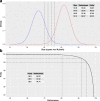Exploring the potential of computer vision analysis of pupae size dimorphism for adaptive sex sorting systems of various vector mosquito species
- PMID: 30583722
- PMCID: PMC6304766
- DOI: 10.1186/s13071-018-3221-x
Exploring the potential of computer vision analysis of pupae size dimorphism for adaptive sex sorting systems of various vector mosquito species
Abstract
Background: Several mosquito population suppression strategies based on the rearing and release of sterile males have provided promising results. However, the lack of an efficient male selection method has hampered the expansion of these approaches into large-scale operational programmes. Currently, most of these programmes targeting Aedes mosquitoes rely on sorting methods based on the sexual size dimorphism (SSD) at the pupal stage. The currently available sorting methods have not been developed based on biometric analysis, and there is therefore potential for improvement. We applied an automated pupal size estimator developed by Grupo Tragsa with laboratory samples of Anopheles arabiensis, Aedes albopictus, Ae. polynesiensis, and three strains of Ae. aegypti. The frequency distribution of the pupal size was analyzed. We propose a general model for the analysis of the frequency distribution of mosquito pupae in the context of SSD-sorting methods, which is based on a Gaussian mixture distribution functions, thus making possible the analysis of performance (% males recovery) and purity (% males on the sorted sample).
Results: For the three Aedes species, the distribution of the pupae size can be modeled by a mixture of two Gaussian distribution functions and the proposed model fitted the experimental data. For a given population, each size threshold is linked to a specific outcome of male recovery. Two dimensionless parameters that measure the suitability for SSD-based sorting of a specific batch of pupae are provided. The optimal sorting results are predicted for the highest values of SSD and lowest values of intra-batch variance. Rearing conditions have a strong influence in the performance of the SSD-sorting methods and non-standard rearing can lead to increase pupae size heterogeneity.
Conclusions: Sex sorting of pupae based on size dimorphism can be achieved with a high performance (% males recovery) and a reasonably high purity (% males on the sorted sample) for the different Aedes species and strains. The purity and performance of a sex sorting operation in the tested Aedes species are linked parameters whose relation can be modeled. The conclusions of this analysis are applicable to all the existing SSD-sorting methods. The efficiency of the SSD-sorting methods can be improved by reducing the heterogeneity of pupae size within rearing containers. The heterogeneity between batches does not strongly affect the quality of the sex sorting, as long as a specific separation threshold is not pre-set before the sorting process. For new developments, we recommend using adaptive and precise threshold selection methods applied individually to each batch or to a mix of batches. Adaptive and precise thresholds will allow the sex-sorting of mixed batches in operational conditions maintaining the target purity at the cost of a reduction in performance. We also recommend a strategy whereby an acceptable level of purity is pre-selected and remains constant across the different batches of pupae while the performance varies from batch to batch to fit with the desired purity.
Keywords: Aedes aegypti; Aedes albopictus; Aedes polynesiensis; Anopheles arabiensis; Biometrical analysis; Morphometrics frequency distribution models; Sex sorting methods; Sexual size dimorphism; Sterile insect technique.
Conflict of interest statement
Ethics approval and consent to participate
Not applicable.
Consent for publication
Not applicable.
Competing interests
The authors declare that they have no competing interests.
Publisher’s Note
Springer Nature remains neutral with regard to jurisdictional claims in published maps and institutional affiliations.
Figures




Similar articles
-
Identification of critical factors that significantly affect the dose-response in mosquitoes irradiated as pupae.Parasit Vectors. 2019 Sep 9;12(1):435. doi: 10.1186/s13071-019-3698-y. Parasit Vectors. 2019. PMID: 31500662 Free PMC article.
-
Combined sterile insect technique and incompatible insect technique: sex separation and quality of sterile Aedes aegypti male mosquitoes released in a pilot population suppression trial in Thailand.Parasit Vectors. 2018 Dec 24;11(Suppl 2):657. doi: 10.1186/s13071-018-3214-9. Parasit Vectors. 2018. PMID: 30583749 Free PMC article.
-
The role of oxygen depletion and subsequent radioprotective effects during irradiation of mosquito pupae in water.Parasit Vectors. 2020 Apr 17;13(1):198. doi: 10.1186/s13071-020-04069-3. Parasit Vectors. 2020. PMID: 32303257 Free PMC article.
-
A perspective on the need and current status of efficient sex separation methods for mosquito genetic control.Parasit Vectors. 2018 Dec 24;11(Suppl 2):654. doi: 10.1186/s13071-018-3222-9. Parasit Vectors. 2018. PMID: 30583720 Free PMC article. Review.
-
A review on the progress of sex-separation techniques for sterile insect technique applications against Anopheles arabiensis.Parasit Vectors. 2018 Dec 24;11(Suppl 2):646. doi: 10.1186/s13071-018-3219-4. Parasit Vectors. 2018. PMID: 30583746 Free PMC article. Review.
Cited by
-
Aedes albopictus Sterile Male Production: Influence of Strains, Larval Diet and Mechanical Sexing Tools.Insects. 2022 Oct 3;13(10):899. doi: 10.3390/insects13100899. Insects. 2022. PMID: 36292847 Free PMC article.
-
Genetic Stability and Fitness of Aedes aegypti Red-Eye Genetic Sexing Strains With Pakistani Genomic Background for Sterile Insect Technique Applications.Front Bioeng Biotechnol. 2022 Mar 31;10:871703. doi: 10.3389/fbioe.2022.871703. eCollection 2022. Front Bioeng Biotechnol. 2022. PMID: 35433649 Free PMC article.
-
A conserved female-specific larval requirement for MtnB function facilitates sex separation in multiple species of disease vector mosquitoes.Parasit Vectors. 2021 Jun 26;14(1):338. doi: 10.1186/s13071-021-04844-w. Parasit Vectors. 2021. PMID: 34174948 Free PMC article.
-
A confinable female-lethal population suppression system in the malaria vector, Anopheles gambiae.Sci Adv. 2023 Jul 7;9(27):eade8903. doi: 10.1126/sciadv.ade8903. Epub 2023 Jul 5. Sci Adv. 2023. PMID: 37406109 Free PMC article.
-
Sterile Insect Technique in an Integrated Vector Management Program against Tiger Mosquito Aedes albopictus in the Valencia Region (Spain): Operating Procedures and Quality Control Parameters.Insects. 2021 Mar 23;12(3):272. doi: 10.3390/insects12030272. Insects. 2021. PMID: 33807092 Free PMC article.
References
-
- Dyck VA, Hendrichs J, Robinson AS. Sterile insect technique: principles and practice in area-wide integrated pest management. Dordrecht: Springer; 2006.
MeSH terms
LinkOut - more resources
Full Text Sources

